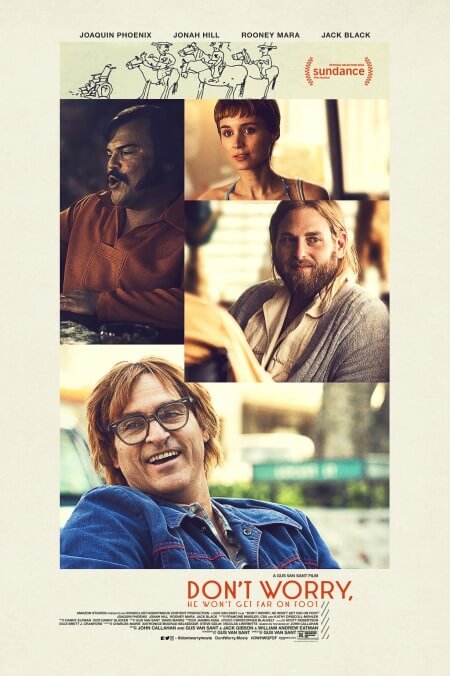Joaquin Phoenix limits his movement and kicks the bottle in Gus Van Sant’s uneven new biopic

Playing a quadriplegic represents a challenge for any able-bodied actor, but it must be particularly frustrating for someone like Joaquin Phoenix, who uses his body no less expressively than he does his face and voice. Don’t Worry, He Won’t Get Far On Foot largely confines Phoenix to a motorized wheelchair, though he’s playing a man—the late cartoonist John Callahan—who was known for zipping around the streets of Portland, Oregon so recklessly that he often wound up being hurled from his chair after hitting a bump or a curb at high speed. All the same, involuntary stillness makes the strongest impression here. Even when Phoenix is acting mostly from the neck up (plus very limited use of his hands), he manages to convey the physical actions that Callahan would take if he only could; there are times when one can almost see him flip a table or throw a glass across the room, when all he’s actually done is tense his brow.
That could easily have been the foundation for an entire uplifting movie: Man gets paralyzed in a car accident at age 21, struggles to regain partial movement in his upper limbs, and improbably finds great success as a cartoonist, specializing in pitch-black humor expressed via necessarily simple yet evocative line drawings. Callahan, however, also dealt with alcoholism, which means that Don’t Worry—adapted by Gus Van Sant from Callahan’s memoir of the same title—must grapple with the numbing familiarity of the 12-step saga. Reluctantly attending an AA meeting, Callahan finds an unconventional sponsor in Donnie (Jonah Hill), a hippie-ish guru with tons of money and (perhaps not coincidentally) little tolerance for self-pity. To both its credit and detriment, the film sticks close to the recovery template, treating Callahan’s disability and eventual minor celebrity as almost incidental—just a couple more things to take one day at a time.
Van Sant, no dummy, knows perfectly well that he’s treading dangerously formulaic water here, despite his singular subject. In an attempt to avoid additional biopic-related stodginess, he takes an impressionistic approach, slicing Callahan’s life into jagged shards and flitting among them with anti-chronological abandon. It’s the right idea, but Van Sant, who’s spent his entire lengthy career shuttling between the daringly experimental (My Own Private Idaho, Gerry, Elephant) and the professionally hidebound (Good Will Hunting, Finding Forrester, Milk), winds up splitting the difference in this case. Predictable content battles prismatic form, making Don’t Worry play like an endless, arrhythmic series of disconnected interludes. It’s a bit like watching one of those DVD bonus features consisting of a bunch of deleted scenes all strung together, except that many of these scenes are much too strong to have ever been deleted.
Ultimately, this is a movie to appreciate in isolated bits and pieces. Some aspects don’t work at all—Rooney Mara, for example, shows up as a physical therapist so bizarrely, one-dimensionally serene that she seems certain to be a figment of Callahan’s imagination, but isn’t. (The A.V. Club now discourages use of a particular four-word description coined by one of our writers, but if you substitute “placid” for “manic” in said phrase, you’ll get the gist.) On the flip side, Jack Black, playing the guy responsible for Callahan’s near-fatal car accident, uses two brief appearances to create a deeply moving contrast between his standard motormouthed persona and someone who literally does not know what to say. Group therapy sessions, while hardly groundbreaking, offer memorable turns from the unlikely trio of Beth Ditto, Kim Gordon, and Udo Kier. And always, there’s Phoenix, visibly straining against his restrictions. He honors Callahan’s unruly passions, even if he’s stuck in a movie that never quite gets its own hair mussed.